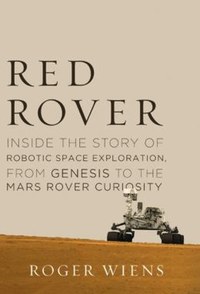Review: Red Roverby Jeff Foust
|
| The book, though, is his engaging account of working on Genesis and Curiosity, offering many insights into the highs and lows involved in building instruments for flight. |
As the images and other data flow in from Curiosity, one can forget about the technical and other obstacles scientists and engineers faced building the instruments that make the science possible. While NASA played up the difficulties of landing Curiosity on Mars in the first place, particularly in its famous “Seven Minutes of Terror” video, it paid less attention to the difficulties involved in developing complex instruments designed to survive the harsh environments of spaceflight, and doing so within severe cost, schedule, and technical constraints. A new book reminds us that building the instruments that make the science possible can be just as challenging as the spacecraft itself.
The subtitle of Roger Wiens’s book, Red Rover, “Inside the Story of Robotic Space Exploration, from Genesis to the Mars Rover Curiosity,” might seem a little odd at first: why those two missions as endpoints? The book, though, is his engaging account of working on those two space missions in particular: he was principal investigator (PI) on three instruments on Genesis, a mission to collect and return samples of the solar wind, and is PI of Curiosity’s ChemCam instrument, which collects spectra of rocks by zapping them with a laser. Those missions provide many insights into the highs and lows involved in building instruments for flight.
Wiens got into this line of work almost by accident. “I was not at all convinced that I should go into the space exploration business” after getting his Ph.D. in the late 1980s, he writes, an understandable assessment given the few space science missions ongoing at the time. But when another job abruptly ended, his only opportunity was to go to Caltech and work with Don Burnett, who was exploring the idea of a spacecraft mission to capture solar wind particles and return them to Earth. That concept evolved into Genesis, selected in 1997 as part of NASA’s Discovery program of low-cost planetary science missions.
Wiens, who by the time of the selection had taken a position at Los Alamos National Laboratory, recounts the roller coaster of emotions involved in the selection of Genesis (the proposal was edged out in an earlier round of the Discovery program) and then the development of the instruments on tight budgets and schedules. It all came together and Genesis launched successfully in 2001, collecting solar wind particles—only to have the sample return capsule crash on its return to Earth in the Utah desert in 2004, its parachute failing to open because accelerometers in the capsule had been installed upside down. Fortunately, the project team was able to salvage many of the samples Genesis collected, and the analysis of the samples helped explain, among other things, variations in the ratios of oxygen isotopes among meteorites and lunar samples.
| In September 2007, NASA said it would cancel ChemCam to save money, even though at that point cancelling it would save less than $2 million. |
By the time Genesis crash-landed back on Earth, though, Wiens was already working on another, very different effort: developing an instrument that used a new technique called laser-induced breakdown spectroscopy. “My imagination was immediately captured by the simplicity of this technique,” after seeing it in action for the first time at Los Alamos in 1997. To him and others, it seemed like an ideal instrument for a Mars rover, and they pursued NASA funding to develop the technology with hopes of getting it onto a future mission, knowing the odds of successfully getting such an instrument on Mars were extremely low. “There are thousands of ideas for planetary exploration floating around,” he notes late in the book, “but the likelihood of success for any one of these is extremely low.”
Much of Red Rover is how Wiens and his team beat those odds with what became the ChemCam instrument. That roller coaster of successes and setbacks is even steeper here, as they encounter, and overcome, a variety of challenges. Some are technical, involving faulty sensors, wiring, and other glitches inherent in any cutting-edge technology project. Others, though, are more programmatic, and even political. ChemCam, and the mission overall, struggled with budgets and schedules that proved, in the long run, to be unrealistic.
At one point, ChemCam almost became a victim of those budget overruns: in September 2007 NASA said it would cancel ChemCam to save money, even though, as Wiens stated in the book, the instrument was a tiny part of the mission’s overall budget and cancelling it at that point would save less than $2 million. (Wiens suggests NASA targeted ChemCam rather than other, more expensive, instruments because it was not being developed at a NASA center.) After an outcry from the instruments supporters on both sides of the Atlantic—the French space agency CNES was also supporting ChemCam’s development—funding for ChemCam was restored. A two-year delay in the launch of Curiosity, because of other problems with the rover, also gave Wiens’s team some breathing room to complete the instrument.
Fortunately, all that effort paid off: Curiosity successfully landed on Mars last August and, later that month, ChemCam zapped its first Martian rock, events he chronicles in the latter chapters of the book. “Our team is both thrilled and working hard, looking at the results,” Wiens said in a press release last August after that initial use of the instrument. “After eight years building the instrument, it's payoff time!” Red Rover illustrates the hard work he and his team put into the instrument over that eight years, and why that payoff they’re enjoying now is so well deserved.
